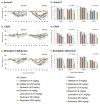Characterization of H7N9 influenza A viruses isolated from humans
- PMID: 23842494
- PMCID: PMC3891892
- DOI: 10.1038/nature12392
Characterization of H7N9 influenza A viruses isolated from humans
Abstract
Avian influenza A viruses rarely infect humans; however, when human infection and subsequent human-to-human transmission occurs, worldwide outbreaks (pandemics) can result. The recent sporadic infections of humans in China with a previously unrecognized avian influenza A virus of the H7N9 subtype (A(H7N9)) have caused concern owing to the appreciable case fatality rate associated with these infections (more than 25%), potential instances of human-to-human transmission, and the lack of pre-existing immunity among humans to viruses of this subtype. Here we characterize two early human A(H7N9) isolates, A/Anhui/1/2013 (H7N9) and A/Shanghai/1/2013 (H7N9); hereafter referred to as Anhui/1 and Shanghai/1, respectively. In mice, Anhui/1 and Shanghai/1 were more pathogenic than a control avian H7N9 virus (A/duck/Gunma/466/2011 (H7N9); Dk/GM466) and a representative pandemic 2009 H1N1 virus (A/California/4/2009 (H1N1pdm09); CA04). Anhui/1, Shanghai/1 and Dk/GM466 replicated well in the nasal turbinates of ferrets. In nonhuman primates, Anhui/1 and Dk/GM466 replicated efficiently in the upper and lower respiratory tracts, whereas the replicative ability of conventional human influenza viruses is typically restricted to the upper respiratory tract of infected primates. By contrast, Anhui/1 did not replicate well in miniature pigs after intranasal inoculation. Critically, Anhui/1 transmitted through respiratory droplets in one of three pairs of ferrets. Glycan arrays showed that Anhui/1, Shanghai/1 and A/Hangzhou/1/2013 (H7N9) (a third human A(H7N9) virus tested in this assay) bind to human virus-type receptors, a property that may be critical for virus transmissibility in ferrets. Anhui/1 was found to be less sensitive in mice to neuraminidase inhibitors than a pandemic H1N1 2009 virus, although both viruses were equally susceptible to an experimental antiviral polymerase inhibitor. The robust replicative ability in mice, ferrets and nonhuman primates and the limited transmissibility in ferrets of Anhui/1 suggest that A(H7N9) viruses have pandemic potential.
Conflict of interest statement
The authors declare the following competing financial interests: Y.K. has received speaker’s honoraria from Chugai Pharmaceuticals, Novartis, Daiichi-Sankyo Pharmaceutical, Toyama Chemical, Wyeth, GlaxoSmithKline and Astellas Inc.; grant support from Chugai Pharmaceuticals, Daiichi Sankyo Pharmaceutical, Toyama Chemical, Otsuka Pharmaceutical Co., Ltd; is a consultant for Crucell; and is a founder of FluGen. G.N. is a founder of FluGen.
Figures




References
-
- 2013 No authors listed( http://www.who.int/influenza/human_animal_interface/influenza_h7n9/China....
-
- Rogers GN, et al. Single amino acid substitutions in influenza haemagglutinin change receptor binding specificity. Nature. 1983;304:76–78. - PubMed
Publication types
MeSH terms
Substances
Grants and funding
LinkOut - more resources
Full Text Sources
Other Literature Sources
Medical

